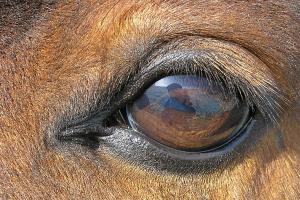By Jennifer Dunlap, DVM
Traumatic injuries to the equine eye are one of the most common emergencies seen in equine veterinary practice. Due to the position of a horse’s eyes in the skull, a horse has nearly 360 degrees of vision, and nearly 65 degrees of this is binocular vision in front of him. Because a horse’s eye protrudes somewhat to allow a wide field of vision, they can be more prone to eyelid lacerations and direct injuries to the cornea, the outer layers of the eye. The obliquely shaped and horizontally placed pupil in a horse’s eye allows it to scan horizons; other features in the horse’s eyes, such as the way their retinas are structured, allow them to pick up movement in even low light conditions. In addition to their upper and lower eyelids, horses also have a third eyelid, the nictitating membrane, in the inner corner of their eyes which helps protect the eye and bathe it with tear film. All of these features are designed to help keep the horse, a prey animal, from being attacked by a predator. Horses do have two main blind spots, a narrow area directly in front of them and a wider area directly behind them. This is often why a stallion gets very upset when a horse is walking closely behind him. He cannot see the horse, but knows he is back there and is waiting for the horse behind him to go on the offensive.
The most common eye issue I see in private practice is damage to the cornea. Injuries to the eye often present with heavy tearing, squinting, and swollen eyelids from a horse rubbing, or cloudiness in the cornea.
It is very important to check your horse’s eyes daily to make sure they are normal. A good way to assess for eye pain is to stand in front of your horse, making sure you do this from a safe position, and check to see that the angles of the upper eyelid eyelashes are the same. A painful eye may have a lash line tilted downward.
A horse’s cornea is made of several layers, like an onion. The cornea should be clear and colorless. When the cornea is injured (scratched, has an abrasion or an ulcer), it can sometimes look cloudy due to inflammation and infection, or have a faint cloudy spot, or you may be able to see an area where it looks like a tiny bit of tissue has been scooped out if the injury is deep. An injury to the cornea is always an emergency, especially here in the Mississippi River valley, due to the risk of a fungal invader that can lead to a fungal infection in the cornea, aka fungal keratitis; this can be very serious and cause severe ulceration of an eye very quickly.
Early and aggressive treatment of a break in the cornea is always the best plan to help prevent the pain, expense, and possible vision loss or loss of an eye that can result if an injury is left untreated for too long. Most of the time treatment will include antibiotic medications placed directly into the eye; atropine, which is used to control pain; and an anti-inflammatory such as Banamine. If there is a fungal infection, then antifungal medication will be needed.
It’s always a good idea to check with your veterinarian before putting anything into your horse’s eye, because some products should not be used in certain situations. For example, placing an ophthalmic medication containing a steroid into an eye with a corneal injury may make that injury much worse.
The size and depth of the injury will determine how often the eye needs to be treated. An ophthalmic exam by a veterinarian is needed to assess the full extent of the injury, so the best treatment plan can be prescribed. Special stains may be applied to the eye, such as fluorescein, to detect breaks in the cornea. Sometimes a culture and cytology may be needed. These two procedures can help determine what bacteria and/or fungus are present in the eye.
Medications may be put directly into the eye via an ointment or a dropper bottle for solutions. But if an injury is severe or non-responsive to routine treatment, then a catheter may need to be placed in either the upper or lower eyelid to allow for very frequent, sometimes every 2 hours, medicating. If a severe fungal infection is present or the ulcer is very deep, surgical intervention may be needed. Fortunately, when caught early, the vast majority of corneal injuries respond quickly to on-the-farm care. But if the eye is punctured completely, is too damaged to repair, or if the bacteria or fungus in the ulcer is extremely aggressive, causing too much damage, then removal of the eye is the best option. This is a choice that is not made lightly and can be very upsetting for most owners to think that their horse is going to lose his or her eye. Though this can be a very difficult decision to make, remember that since horses have nearly 360 degree vision, the majority of horses who have lost an eye can still do extremely well long-term and lead normal lives. They may need an adjustment period as they get used to being visionless on one side and owners should talk softly to a horse when on the blind side so the horse knows where they are.
The second most common eye issue seen is eyelid lacerations. Eyelid function must be preserved at all costs to keep the eye protected. If the eyelid doesn’t function normally or is missing, then the eye is not protected and isn’t continually bathed in tear film. Thus, an exposure keratitis can develop in the portion of the eye that is left unprotected, which can lead to scarring, ulceration, and vision loss. So cutting the flapping torn eyelid off is never the right thing to do! It is very important to have a veterinarian carefully suture the eyelid back in place to maintain normal function of the lid and protect the eye. It is also wise to do an ophthalmic exam to make sure the eye itself is not injured.
Bucket handle hooks are a common contributor to eyelid lacerations, so check your horse’s housing for bucket handles that are bent or sticking up, nails sticking out, sharp corners, or other dangerous issues that could cause a problem for your horse. As we all know, sometimes horses can injure themselves no matter how careful we are! But these measures will decrease the risk of injury.
One of my favorite expressions was told to me by a veterinarian years ago: “Eyes can go to heck in a hand basket in a heartbeat.” This summarizes the importance of emergency care for any equine eye injury. Eye injuries can be frightening to deal with, and are obviously very painful for your horse, so the faster they are treated the better the outcome.
About the author: Dr. Jennifer Dunlap owns and operates Dunlap Equine Services offering 24/7 equine care and emergency services. Find more information at www.dunlapequineservices.com and on facebook at Dunlap Equine Services.
Dr. Dunlap speaks on “Colic Prevention and Treatment” at the Eads Civic Center, 12365 Washington Road in Eads, Tenn. on November 12, 2018 at 6:30 p.m. She will go over the ways to help prevent colic, what to do if your horse colics, and things you can have on hand for a colic emergency kit. Pizza and drinks will be provided. There will also be a bake sale to benefit the non-profit 501(c)(3) Animal Response Foundation, which aids animal victims of cruelty/neglect and disasters in west Tennessee by providing assistance, when invited by law enforcement, in animal handling during seizures, emergency animal transportation and sheltering. The organization also provides education to animal shelters, law enforcement, and the public regarding both large (horse) and small (cat and dog) animal handling in disaster and emergency situations.
Traumatic injuries to the equine eye are one of the most common emergencies seen in equine veterinary practice. Due to the position of a horse’s eyes in the skull, a horse has nearly 360 degrees of vision, and nearly 65 degrees of this is binocular vision in front of him. Because a horse’s eye protrudes somewhat to allow a wide field of vision, they can be more prone to eyelid lacerations and direct injuries to the cornea, the outer layers of the eye. The obliquely shaped and horizontally placed pupil in a horse’s eye allows it to scan horizons; other features in the horse’s eyes, such as the way their retinas are structured, allow them to pick up movement in even low light conditions. In addition to their upper and lower eyelids, horses also have a third eyelid, the nictitating membrane, in the inner corner of their eyes which helps protect the eye and bathe it with tear film. All of these features are designed to help keep the horse, a prey animal, from being attacked by a predator. Horses do have two main blind spots, a narrow area directly in front of them and a wider area directly behind them. This is often why a stallion gets very upset when a horse is walking closely behind him. He cannot see the horse, but knows he is back there and is waiting for the horse behind him to go on the offensive.
The most common eye issue I see in private practice is damage to the cornea. Injuries to the eye often present with heavy tearing, squinting, and swollen eyelids from a horse rubbing, or cloudiness in the cornea.
It is very important to check your horse’s eyes daily to make sure they are normal. A good way to assess for eye pain is to stand in front of your horse, making sure you do this from a safe position, and check to see that the angles of the upper eyelid eyelashes are the same. A painful eye may have a lash line tilted downward.
A horse’s cornea is made of several layers, like an onion. The cornea should be clear and colorless. When the cornea is injured (scratched, has an abrasion or an ulcer), it can sometimes look cloudy due to inflammation and infection, or have a faint cloudy spot, or you may be able to see an area where it looks like a tiny bit of tissue has been scooped out if the injury is deep. An injury to the cornea is always an emergency, especially here in the Mississippi River valley, due to the risk of a fungal invader that can lead to a fungal infection in the cornea, aka fungal keratitis; this can be very serious and cause severe ulceration of an eye very quickly.
Early and aggressive treatment of a break in the cornea is always the best plan to help prevent the pain, expense, and possible vision loss or loss of an eye that can result if an injury is left untreated for too long. Most of the time treatment will include antibiotic medications placed directly into the eye; atropine, which is used to control pain; and an anti-inflammatory such as Banamine. If there is a fungal infection, then antifungal medication will be needed.
It’s always a good idea to check with your veterinarian before putting anything into your horse’s eye, because some products should not be used in certain situations. For example, placing an ophthalmic medication containing a steroid into an eye with a corneal injury may make that injury much worse.
The size and depth of the injury will determine how often the eye needs to be treated. An ophthalmic exam by a veterinarian is needed to assess the full extent of the injury, so the best treatment plan can be prescribed. Special stains may be applied to the eye, such as fluorescein, to detect breaks in the cornea. Sometimes a culture and cytology may be needed. These two procedures can help determine what bacteria and/or fungus are present in the eye.
Medications may be put directly into the eye via an ointment or a dropper bottle for solutions. But if an injury is severe or non-responsive to routine treatment, then a catheter may need to be placed in either the upper or lower eyelid to allow for very frequent, sometimes every 2 hours, medicating. If a severe fungal infection is present or the ulcer is very deep, surgical intervention may be needed. Fortunately, when caught early, the vast majority of corneal injuries respond quickly to on-the-farm care. But if the eye is punctured completely, is too damaged to repair, or if the bacteria or fungus in the ulcer is extremely aggressive, causing too much damage, then removal of the eye is the best option. This is a choice that is not made lightly and can be very upsetting for most owners to think that their horse is going to lose his or her eye. Though this can be a very difficult decision to make, remember that since horses have nearly 360 degree vision, the majority of horses who have lost an eye can still do extremely well long-term and lead normal lives. They may need an adjustment period as they get used to being visionless on one side and owners should talk softly to a horse when on the blind side so the horse knows where they are.
The second most common eye issue seen is eyelid lacerations. Eyelid function must be preserved at all costs to keep the eye protected. If the eyelid doesn’t function normally or is missing, then the eye is not protected and isn’t continually bathed in tear film. Thus, an exposure keratitis can develop in the portion of the eye that is left unprotected, which can lead to scarring, ulceration, and vision loss. So cutting the flapping torn eyelid off is never the right thing to do! It is very important to have a veterinarian carefully suture the eyelid back in place to maintain normal function of the lid and protect the eye. It is also wise to do an ophthalmic exam to make sure the eye itself is not injured.
Bucket handle hooks are a common contributor to eyelid lacerations, so check your horse’s housing for bucket handles that are bent or sticking up, nails sticking out, sharp corners, or other dangerous issues that could cause a problem for your horse. As we all know, sometimes horses can injure themselves no matter how careful we are! But these measures will decrease the risk of injury.
One of my favorite expressions was told to me by a veterinarian years ago: “Eyes can go to heck in a hand basket in a heartbeat.” This summarizes the importance of emergency care for any equine eye injury. Eye injuries can be frightening to deal with, and are obviously very painful for your horse, so the faster they are treated the better the outcome.
About the author: Dr. Jennifer Dunlap owns and operates Dunlap Equine Services offering 24/7 equine care and emergency services. Find more information at www.dunlapequineservices.com and on facebook at Dunlap Equine Services.
Dr. Dunlap speaks on “Colic Prevention and Treatment” at the Eads Civic Center, 12365 Washington Road in Eads, Tenn. on November 12, 2018 at 6:30 p.m. She will go over the ways to help prevent colic, what to do if your horse colics, and things you can have on hand for a colic emergency kit. Pizza and drinks will be provided. There will also be a bake sale to benefit the non-profit 501(c)(3) Animal Response Foundation, which aids animal victims of cruelty/neglect and disasters in west Tennessee by providing assistance, when invited by law enforcement, in animal handling during seizures, emergency animal transportation and sheltering. The organization also provides education to animal shelters, law enforcement, and the public regarding both large (horse) and small (cat and dog) animal handling in disaster and emergency situations.








